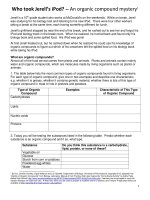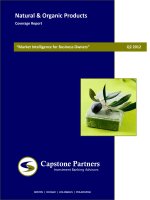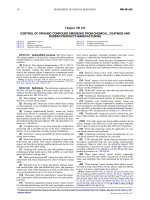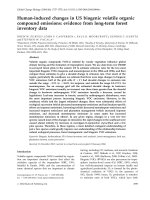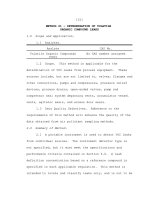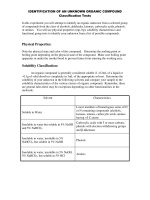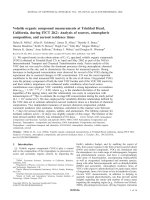National Volatile Organic Compound Emission Standards for Architectural Coatings -- Background for Promulgated Standards docx
Bạn đang xem bản rút gọn của tài liệu. Xem và tải ngay bản đầy đủ của tài liệu tại đây (761.4 KB, 477 trang )
National Volatile Or
g
anic Compound
Emission Standards for Architectural
Coatin
g
s Back
g
round for
Promul
g
ated Standards
E
PA
Air
United States
Environmental Protection
Agency
Office of Air Quality
Planning and Standards
Research Triangle Park NC 27711
EPA-453/R-98-006b
August 1998
EPA-453/R-98-006b
National Volatile Organic Compound
Emission Standards for Architectural Coatings
Background for Promulgated Standards
(Architectural Coating Background Information Document)
U.S. Environmental Protection Agency
Office of Air and Radiation
Office of Air Quality Planning and Standards
Research Triangle Park, North Carolina 27711
August 1998
ii
Disclaimer
This report has been reviewed by the Emission Standards Division
of the Office of Air Quality Planning and Standards,
U.S. Environmental Protection Agency, and approved for
publication. Mention of trade names or commercial products is
not intended to constitute endorsement or recommendation for use.
Copies of this report are available through the Library Services
Offices (MD-35), U.S. Environmental Protection Agency, Research
Triangle Park, N.C. 27711, (919)541-2777, from National
Technical Information Services, 5285 Port Royal Road,
Springfield, Virginia 22161, (703)487-4650, or from the Internet
( />iii
TABLE OF CONTENTS
Section Page
1.0 INTRODUCTION 1-1
1.1 SUMMARY OF CHANGES SINCE PROPOSAL 1-1
1.1.1 Applicability and compliance dates 1-1
1.1.2 Definitions 1-1
1.1.3 VOC Content Limits 1-4
1.1.4 Overlap Concerns 1-4
1.1.5 Container labeling requirements 1-5
1.1.6 Variances provision 1-6
1.1.7 Tonnage Exemption 1-6
1.1.8 Exceedance Fee Option 1-6
1.1.9 Recordkeeping and Reporting 1-6
1.1.10 Compliance Provisions 1-6
1.1.11 Reorganization of Rule Text 1-7
2.0 SUMMARY OF PUBLIC COMMENTS AND RESPONSES 2-1
2.1 METHOD OF REGULATION 2-37
2.1.1 Section 183(e) Requirements 2-37
2.1.2 National Rule Versus Other Strategies . . 2-39
2.1.3 Miscellaneous 2-53
2.2 PROPOSED STANDARDS 2-55
2.2.1 Applicability of the Standards 2-55
2.2.1.1 General 2-55
2.2.1.2 Low-Volume Exemption 2-80
2.2.1.3 Small Container Exemption . . . 2-88
2.2.2 Processors as Regulated Entities 2-90
2.2.3 Definitions 2-94
2.2.3.1 General 2-94
2.2.3.2 Pigmented 2-95
2.2.3.3 Lacquers 2-95
2.2.3.4 Quick-dry Enamel 2-97
2.2.3.5 Traffic Marking Coating . . . 2-98
2.2.3.6 Sealer 2-99
2.2.3.7 Industrial Maintenance
Coatings 2-99
2.2.3.8 High Temperature Coating . . . 2-103
2.2.3.9 Extreme High Durability
Coating 2-103
2.2.3.10 Swimming Pool Coatings 2-104
2.2.3.11 Reformulation 2-104
2.2.3.12 Shellac 2-105
2.2.3.13 Flow Coating 2-107
2.2.3.14 Overlap Issues 2-108
2.2.4 Coating Categories and VOC Content
Limits 2-124
2.2.4.1 General 2-125
2.2.4.2 Requests for New Categories . 2-143
2.2.4.3 Proposed Categories 2-192
TABLE OF CONTENTS (CONTINUED)
Section Page
iv
2.2.4.4 Recycled Coatings 2-242
2.2.5 Compliance Time Requirements 2-244
2.2.5.1 General 2-244
2.2.5.2 Small Business Compliance Time
Extension 2-252
2.2.6 Labeling, Recordkeeping and Reporting . . 2-256
2.2.6.1 Labeling 2-256
2.2.6.2 Recordkeeping and Reporting . 2-268
2.2.7 Determination of Volatile Organic
Compound Content 2-272
2.2.8 Variance Provisions 2-279
2.2.9 Clarifications 2-286
2.3 IMPACTS 2-289
2.3.1 Environmental and Energy 2-289
2.3.1.1 HAP Implications 2-289
2.3.1.2 Emission Reduction Estimate . . 2-290
2.3.1.3 Wastewater/Solid Waste
Impacts 2-302
2.3.1.4 Energy Impacts 2-304
2.3.2 Cost/Economic 2-304
2.3.2.1 Reformulation Cost Estimate . . 2-304
2.3.2.2 Annual Cost to Industry 2-320
2.3.2.3 Costs not Considered 2-338
2.3.2.4 Cost-effectiveness 2-342
2.3.2.5 Disproportionate Impacts on
Small Businesses 2-347
2.3.2.6 Effect of Rule on Competition . 2-360
2.3.2.7 Economic Hardship 2-367
2.3.2.8 Small Business Administration . 2-372
2.3.2.9 Definition of “Small Business” 2-373
2.3.2.10 Cost-Benefit Perspective . . . 2-375
2.3.2.11 Executive Order 12866, Small
Business Regulatory Enforcement
Fairness Act,Unfunded Mandates
Reform Act 2-376
2.3.2.12 Adverse Socioeconomic and
Related Impacts. 2-378
2.4 EXCEEDANCE FEE 2-381
2.4.1 Exceedance Fee Concept 2-381
2.4.2 Exceedance Fee Levels 2-389
2.4.3 Use of Collected Exceedance Fees 2-394
2.4.4 Exceedance Fee Recordkeeping and
Reporting 2-395
2.5 REGULATORY NEGOTIATION 2-396
2.5.1 Section 183(e) Requirements and the
Architectural Coatings Regulatory
Negotiations 2-396
TABLE OF CONTENTS (CONTINUED)
Section Page
v
2.5.2 Regulatory Negotiations Committee Was
Not Properly Constituted 2-400
2.5.3 Regulatory Negotiations Procedure 2-405
2.5.4 Miscellaneous 2-409
2.6 FUTURE STUDY 2-411
2.7 LEGAL ISSUES 2-420
2.7.1 Publication requirements of the Clean
Air Act and the Administrative
Procedure Act 2-420
2.7.2 Compliance With the Regulatory Flexibility
Act (RFA) and the Small Business
Regulatory Enforcement Fairness Act
(SBREFA) 2-423
2.7.3 Unfunded Mandate Reform Act (UMRA) . . . 2-430
2.7.4 Environmental Justice 2-432
2.7.5 Executive Order 12866 2-434
2.7.6 The U.S. Constitution 2-436
2.7.6.1 Interstate Commerce Clause . . 2-436
2.7.6.2 Coating Manufacturers' First
Amendment Rights (Freedom of
Speech, Association) 2-438
2.7.6.3 Taking Under the Fifth
Amendment 2-444
2.7.6.4 The Tenth Amendment
(Delegation Powers) 2-450
2.8 OUTREACH 2-452
vi
LIST OF TABLES
Table Page
2-1 LIST OF COMMENTERS ON THE PROPOSED NATIONAL ARCHITECTURAL
COATINGS RULE 2-2
2-2 CONCRETE CURING AND SEALING DATA 2-128
1-1
1.0 INTRODUCTION
1.1 SUMMARY OF CHANGES SINCE PROPOSAL
Several changes have been made to the proposed rule as a
result of public comments. The significant changes to the
proposed rule are presented in this section. All of the changes
made to the proposed rule and the rationale for these changes are
discussed more fully in responses to comments in chapter 2 of
this document.
1.1.1 Applicability and compliance dates
The compliance date for manufacturers and importers of
architectural coatings, except coatings registered under the
Federal Insecticide, Fungicide and Rodenticide Act (FIFRA)
(7 USC 136 et seq.) has been extended to 12 months after the date
the final rule is published in the Federal Register. The
compliance date for coatings registered under FIFRA is 18 months
after publication of the final rule.
1.1.2 Definitions
Several changes have been made in the definitions section:
1. Definitions for the following seven new coating
categories have been added: calcimine recoaters,
concrete curing and sealing compounds, concrete surface
retarders, conversion varnishes, faux finishing, stain
controllers, and zone markings. These categories are
defined in section 2.2.4.2 of this document.
2. A sentence has been added to the definition of lacquer
to clarify that lacquer stains must meet the volatile
organic compound (VOC) content limit for stains rather
than lacquers. Also, a definition for stains,
including lacquer stains, has been added.
3. The term “community-based paint exchange” in the
definitions section of the rule has been changed to
1-2
“paint exchange” to include other paint exchanges
besides community-based ones, and the definition has
been amended to exclude architectural coating
manufacturers and importers.
4. The definition of “industrial maintenance coating” has
been revised to reflect that the use of such a coating
is intended for extreme environmental conditions in an
industrial, commercial, or institutional setting.
5. In the definition of “shellac”, nitrocellulose has been
excluded because of overlap with lacquers (the lacquer
definition in the rule includes cellulosic or synthetic
resins).
6. The definition of “extreme high durability coatings”
has been expanded to include in this category lower VOC
coatings, in addition to fluoropolymer-based coatings,
that also meet the weathering requirements of the
American Architectural Manufacturer’s Association
(AAMA) Specification 605.2.
7. The definition of “pigmented” has been expanded to
include the following properties of pigments: color,
corrosion inhibition, conductivity, fouling resistance,
opacity, and improved mechanical properties.
8. The minimum temperature requirement in the definition
of “high temperature coating” has been lowered to
400 degrees F. to be consistent with industry practice
and existing State architectural coating rules.
9. The definition of “anti-graffiti coating” has been
amended to remove the phrase “specifically labeled as
an anti-graffiti coating” to be consistent with
labeling requirements for other coating categories.
10. A definition of “shop application” has been added to
clarify that coatings applied in a shop setting or
during a manufacturing process are not subject to the
rule.
11. The definition of “coating” has been amended to remove
reference to application as a film because the EPA did
not intend to limit rule applicability based upon the
product thickness as applied. Also, a sentence has
been added to further clarify what coatings are
regulated. The revised definition follows: “Coating
means a material applied onto or impregnated into a
substrate for protective, decorative or functional
purposes. Such materials include, but are not limited
to, paints, varnishes, sealants, inks, maskants, and
temporary coatings. Protective, decorative or
1-3
functional materials that consist only of solvents,
acids, bases, or any combination of these substances
are not considered coatings for the purpose of this
subpart.”
12. The definition of “architectural coating” has been
amended to exclude adhesives, coatings recommended
solely for shop application, and coatings recommended
solely for application to non-stationary structures,
such as airplanes, ships, boats and railcars because
they were not intended to be covered. Also,
definitions of “adhesive” and “shop application” have
been added to the rule for further clarification.
13. A definition of “United States” has been added to
clarify that the rule applies to the 50 States, the
District of Columbia, and United States territories.
14. The definitions of “importer” and “manufacturer” have
been amended to clarify that any person who repackages
a coating by transferring it from one container to
another is excluded from these definitions, provided
the coating VOC content is not altered and the coating
is not sold or distributed to another party. Also, a
sentence has been added in these definitions for
further clarification of applicability and a definition
of "person" has been added to clarify its use in these
definitions.
15. Definitions of “imported” and “manufactured” have been
added to clarify the point at which an architectural
coating becomes subject to the requirements in the
rule.
16. The definition of “graphic arts coating” has been
revised to delete the reference to “in shop” since shop
applications are not regulated under this rule.
17. In the definition of “floor coating”, the word “opaque”
has been added to further define these coatings, and a
definition of “opaque” has been added to the rule. In
addition, the words “in a residential setting” have
been added to distinguish coatings meant to be subject
to the 400 g/l limit for floor coatings from those
floor coatings intended for use in an industrial,
institutional, or commercial setting, which would be
subject to the 450 g/l limit for industrial maintenance
coatings.
18. Although there were no comments on the definition of
"sale" in the Definitions section of the proposed rule,
the Agency deleted this term because it was
unnecessary.
1-4
1.1.3 VOC Content Limits
Seven additional categories and associated VOC content
limits have been established for the following coatings:
(1) calcimine recoaters at 475 g/l; (2) concrete surface
retarders at 780 g/l; (3) concrete curing and sealing compounds
at 700 g/l; (4) conversion varnishes at 725 g/l; (5) faux
finishing/glazing at 700 g/l; (6) zone markings at 450 g/l; and
(7) stain controllers at 720 g/l. In addition, the VOC content
limits for some of the proposed coating categories have been
revised as follows: (1) antifouling from 400 g/l to 450 g/l; (2)
nuclear from 420 g/l to 450 g/l; (3) clear shellacs from 650 g/l
to 730 g/l; and (4) combined opaque and clear waterproofing
sealers and treatments at 600 g/l (opaque was proposed at
400 g/l).
1.1.4 Overlap Concerns
Several changes have been made to address some commenters’
concerns that a coating that is developed and designated for a
particular use by definition could be subject to a more
restrictive limit if the coating is suitable for use in another
category with a lower limit. In order to address these overlap
concerns, paragraphs (b) and (c)(1)-(c)(7)of § 59.402 have been
amended, and new paragraphs (c)(8)-(c)(15) have been added to
§ 59.402. The new provisions in paragraphs (c)(8)-(c)(15)
address overlap concerns in the following categories:
1. Varnishes and conversion varnishes that are recommended
for use as floor coatings are only subject to the VOC
content limit for varnishes and conversion varnishes,
respectively.
2. Anti-graffiti coatings, high temperature coatings,
impacted immersion coatings, thermoplastic rubber
coatings and mastics, repair and maintenance
thermoplastic coatings, and flow coatings that also
meet the definition for industrial maintenance coatings
are only subject to the VOC content limit for that
particular category (i.e., not subject to the
industrial maintenance coating VOC content limit).
3. Waterproofing sealers and treatments that also meet the
definition for quick-dry sealers are only subject to
1-5
the VOC content limit for waterproofing sealers and
treatments.
4. Sanding sealers that also meet the definition for
quick-dry sealers are only subject to the VOC content
limit for sanding sealers.
5. Nonferrous ornamental metal lacquers and surface
protectants that also meet the definition for lacquers
are only subject to the VOC content limit for
nonferrous ornamental metal lacquers and surface
protectants.
6. Quick-dry primers, sealers, and undercoaters that also
meet the definition for primers and undercoaters are
only subject to the VOC content limit for quick-dry
primers, sealers, and undercoaters.
7. Antenna coatings that also meet the definition for
industrial maintenance coatings or primers are only
subject to the VOC content limit for antenna coatings.
8. Bituminous coatings and mastics that are recommended
for use as any other architectural coating are subject
only to the limit for bituminous coatings and mastics.
1.1.5 Container labeling requirements
1. The proposed labeling requirements were amended to
clarify that to meet the labeling requirements for
containers of architectural coatings, manufacturers and
importers are allowed to use either (1) the VOC content
limit for the category with which the product is
required to comply and with which it does comply, or
(2) the VOC content of the coating. In other words,
the manufacturer or importer is not required to provide
the actual VOC content of the coating. The labeled VOC
content must account for the manufacturer’s or
importer’s thinning recommendation.
2. The proposed requirement for industrial maintenance
coatings to be labeled “not for residential use” has
been modified to allow flexibility in the wording of
the labeling statement.
3. The labeling section of the proposed rule has been
modified to allow the date of manufacture or date code
to appear on either the container lid, label, or bottom
of the can.
1-6
1.1.6 Variances provision
The variances provision in the proposed rule was not
included in the final rule. The rationale for this change is
discussed in section 2.2.8 of this document.
1.1.7 Tonnage Exemption
A VOC tonnage exemption has been included in the final rule,
based upon the proposed low-volume exemption. Under this
provision, each manufacturer can exempt a total of 23 megagrams
(25 tons) of VOC emissions in the time period from the compliance
date to December 31, 2000; 18 megagrams (20 tons) in the year
2001; and 9 megagrams (10 tons) in the year 2002 and in each year
beyond. The tonnage exemption is discussed in section 2.2.1.2 of
this document. This provision is designed to accommodate the
needs of small manufacturers, niche markets, and specialty
products while effectively limiting the VOC emissions from the
exemption. This exemption is needed to help ensure the economic
feasibility of the rule.
1.1.8 Exceedance Fee Option
Provisions for an exceedance fee option have been included
in the final rule. Under this approach, manufacturers and
importers have the option of paying a fee, based on the amount
that their coatings exceed the applicable VOC content limits,
instead of achieving the VOC content limits listed in the rule.
This allows manufacturers and importers to continue to market
non-compliant coatings while they develop compliant or new
coatings. This provision is a market-based incentive to
encourage manufacturers and importers to develop compliant
coatings while at the same time recognizing that for some
manufacturers of some coatings, additional time is needed.
1.1.9 Recordkeeping and Reporting
Recordkeeping and reporting requirements have been included
for manufacturers and importers using the tonnage exemption and
exceedance fee option.
1.1.10 Compliance Provisions
A new section has been included in the rule to consolidate
the proposed rule’s provisions for determining compliance.
1-7
Language has been added to clarify the requirements that were
proposed regarding determination of VOC content.
1.1.11 Reorganization of Rule Text
The rule text has been reorganized for clarity and ease of
understanding.
2-1
2.0 SUMMARY OF PUBLIC COMMENTS AND RESPONSES
The U.S. Environmental Protection Agency (EPA) received a
total of 243 letters commenting on the proposed standards and the
background information document (BID) for the proposed standards.
The EPA held a public hearing on July 30, 1996 in Durham, North
Carolina, at which 19 commenters presented oral comments. In
addition, the EPA held a public meeting on August 13, 1996 in
Rosemont, Illinois, in which 77 persons participated. At this
public meeting, 18 manufacturers provided company profiles. Some
commenters provided more than one comment letter or commented at
the public hearing or meeting. Each letter or comment has a
separate comment number. Comments are designated as follows:
IV-D-(number) written comment received during comment
period
IV-F-1(letter) comment received at public hearing
IV-F-2(letter) comment received at public meeting
IV-G-(number) comment received after comment period
In this promulgation BID, commenters with multiple comment
letters or statements at the hearing or meeting are identified
with a slash between comments. For example, if a commenter
provided written comments and public hearing comments, the
commenter is identified as (IV-D-number/IV-F-1 letter). Copies
of comment letters, meeting transcripts, and telecons are located
in docket A-92-18. The docket is available for public inspection
between 8:00 a.m. and 5:30 p.m., Monday through Friday, at the
EPA’s Air and Radiation Docket and Information Center (Mail
Code 6102), 401 M Street S.W., Washington, DC 20460, or by
calling (202) 260-7548. A list of the commenters, their
2-2
affiliations, and the EPA docket number assigned to their
correspondence is given in table 2-1.
The comments and responses, and therefore the organization
of this document, have been categorized under the following
topics:
Method of Regulation;
Proposed Standards;
Impacts;
Exceedance Fee;
Regulatory Negotiations;
Future Study;
Legal Issues; and
Outreach.
This document contains summaries and responses to comments
mainly covering the provisions of the proposed architectural
coatings rule. To avoid duplication, most comments that pertain
to the EPA’s study, Report to Congress, and schedule for
regulations under section 183(e) are discussed in a separate
comment/response document, Response to Comments on Section 183(e)
Study and Report to Congress referred to as the 183-BID.
2-3
TABLE 2-1. LIST OF COMMENTERS ON THE PROPOSED NATIONAL
ARCHITECTURAL COATINGS RULE
Docket Number Commenter and affiliation
IV-D-01 Mr. James E. Thomas, Jr.
CEO
Jetco, Inc.
Post Office Box 11494
Memphis, Tennessee 38111
IV-D-02 Mr. Ned B. Kisner
President
Triangle Coatings, Inc.
1930 Fairway Drive
San Leandro, California 94577
IV-D-03 Mr. Kisuk Cheung
Chief, Engineering Division
Department of the Army
U.S. Army Corps of Engineers
Washington, DC 20314-1000
IV-D-04 Mr. Benard R. Appleman
Executive Director
Steel Structures Painting Council
40 24th Street, 6th Floor
Pittsburgh, Pennsylvania 15222-4643
IV-D-05 Mr. William A. Rostine
President
Rostine Manufacturing and Supply, Inc.
Post Office Box 8192
4227C W. Church
Springfield, Missouri 65801
IV-D-06 Mr. Ronald B. Child
Vice President of Compliance & Reg. Affairs
California Products Corporation
Post Office Box 390569
Cambridge, Massachusetts 02139-0007
IV-D-07 F.H. McGary
Vice President Manufacturing
Star Bronze Company, Inc.
Post Office Box 2206
Alliance, Ohio 44601-0206
IV-D-08 Mr. Richard Hardy
President
XIM Products, Inc.
1169 Bassett Road
Westlake, Ohio 44145
TABLE 2-1. LIST OF COMMENTERS ON THE PROPOSED NATIONAL
ARCHITECTURAL COATINGS RULE (CONTINUED)
Docket Number Commenter and affiliation
2-4
IV-D-09 Mr. Jim Gardner
President
Trinity Coatings Company
Post Office Box 2488
Fort Worth, Texas 76113-2488
IV-D-10 Mr. James S. Jennison
President
Jennison Industries
106 Washington
Post Office Box 965
Burlington, Iowa 52601
IV-D-11 Mr. Robert E. Mitchell
Chairman of the Board
Dunn-Edwards Corporation
4885 East 52nd Place
Los Angeles, California 90040
IV-D-12 Ms. Susan J. Binder
Division Administrator
Federal Highway Administration
U.S. Department of Transportation
State Highway Administration,
Maryland Division
711 West 40th Street, Suite 220
Baltimore, Maryland 21211-2187
IV-D-13 Mr. Robert C. Maindelle
Environmental Specialist
Wilsonart International, Inc.
Post Office Box 6110
Temple, Texas 76503-6110
IV-D-14 Mr. Robert E. Mitchell
Chairman of the Board
Dunn-Edwards Corporation
4885 East 52nd Place
Los Angeles, California 90040
IV-D-15 duplicate of Item IV-D-8, removed from
docket.
IV-D-16 Mr. James S. Jennison
President
Jennison Industries
Post Office Box 965
Burlington, Iowa 52601
TABLE 2-1. LIST OF COMMENTERS ON THE PROPOSED NATIONAL
ARCHITECTURAL COATINGS RULE (CONTINUED)
Docket Number Commenter and affiliation
2-5
IV-D-17 Mr. Gene Bartlow
President and CEO
American Wood Preservers Institute
1945 Old Gallows Road, Suite 150
Vienna, Virginia 22182-3931
IV-D-18 Mr. John F. Montle
Vice President-Technology
Carboline Company
350 Hanley Industrial Court
St. Louis, Missouri 63144
IV-D-19 Mr. Benard R. Appleman
Executive Director
Steel Structures Painting Council
40 24th Street, 6th Floor
Pittsburgh, Pennsylvania 15222-4643
IV-D-20 Mr. Ben Gavett
Director of Safety & Compliance
Golden Artist Colors, Inc.
188 Bell Road
New Berlin, New York 13411
IV-D-21 Mr. David Schmetterer
Vice President
Crawford Laboratories
4165 South Emerald Avenue
Chicago, Illinois 60609
IV-D-22 Mr. S. William Becker
Executive Director
STAPPA/ ALAPCO
444 North Capitol Street, N.W.
Washington, DC 20001
IV-D-23 Ms. Linda M. Loreth
Environmental, Health, and Safety Manager
A.W. Chesterton Company
Post Office Box 9101
Stoneham, Massachusetts 02180-9101
IV-D-24 Mr. Christopher L. Runyan
Assistant Director of Transportation Policy
Ohio Department of Transportation
Central Office
Post Office Box 899
Columbus, Ohio 43216-0899
TABLE 2-1. LIST OF COMMENTERS ON THE PROPOSED NATIONAL
ARCHITECTURAL COATINGS RULE (CONTINUED)
Docket Number Commenter and affiliation
2-6
IV-D-25 Mr. Robert Senior
Wm. Zinsser & Company, Inc.
39 Belmont Drive
Somerset, New Jersey 08875-1285
IV-D-26 Mr. Alaistair MacDonald
CEO
Specialty Coatings & Chemicals, Inc.
7360 Varna Avenue
North Hollywood, California 91605
IV-D-27 Mr. T. Leon Everett
President & CEO
Dan-Tex Paint & Coating Manufacturing
Company, Inc.
444 Aston Drive
Sunnyvale, Texas 75182
IV-D-28 Mr. Karl R. Schultz
Environmental Consultant
DuPont Automotive Products
Wilmington, Delaware 19898
IV-D-29 Mr. Ned B. Kisner
Triangle Coatings, Inc.
1930 Fairway Drive
San Leandro, California 94577
IV-D-30 Mr. James G. Stilling
Vice President and General Manager
W.R. Meadows, Inc.
Post Office Box 543
Elgin, Illinois 60121
IV-D-31 Mr. David P. Straub
Executive Director
Metal Maintenance Industry Association, Inc.
352 Seventh Avenue
New York, New York 10001
IV-D-32 Mr. Gregory A. Green
Administrator
Air Quality Division
Oregon Department of Environmental Quality
811 S.W. Sixth Avenue
Portland, Oregon 97204-1390
TABLE 2-1. LIST OF COMMENTERS ON THE PROPOSED NATIONAL
ARCHITECTURAL COATINGS RULE (CONTINUED)
Docket Number Commenter and affiliation
2-7
IV-D-33 Ms. Barbara A. Kwetz
Director
Division of Air Quality Control
Commonwealth of Massachusetts
Department of Environmental Protection
One Winter Street
Boston, Massachusetts 02108
IV-D-34 Mr. James M. Lents
Executive Officer
South Coast Air Quality Management District
21865 E. Copley Drive
Diamond Bar, California 91765-4182
IV-D-35 Ms. Linda M. Loreth
Environmental, Health and Safety Manager
A.W. Chesterton Company
225 Fallon Road
Post Office Box 9101
Stoneham, Massachusetts 02180-9101
IV-D-36 Ms. Pamela S. Clark
Preservo Paint Manufacturing
2401 Broiller
Post Office Box 20125
Houston, Texas 77225
IV-D-37 Mr. Daniel L. Stein and V.B. Winge
3M Traffic Control Materials Division
3M Center Building 582-1-15
St. Paul, Minnesota 55144-1000
IV-D-38 Mr. Jimmy D. Adams
American Coatings, Inc.
Post Office Box 1426
Tomball, Texas 77377-1426
IV-D-39 Anonymous
IV-D-40 Mr. Darryl E. Durgin
Deputy Commissioner
Minnesota Department of Transportation
Office of Traffic Engineering
Mail Stop 725
1500 West County Road B2, Suite 250
Roseville, Minneapolis 55113
TABLE 2-1. LIST OF COMMENTERS ON THE PROPOSED NATIONAL
ARCHITECTURAL COATINGS RULE (CONTINUED)
Docket Number Commenter and affiliation
2-8
IV-D-41 Mr. Don Diller
Director
Wyoming Department of Transportation
Post Office Box 1708
Cheyenne, Wyoming 82003-1708
IV-D-42 Mr. Robert Senior
Wm. Zinsser & Company, Inc.
173 Belmont Drive
Somerset, New Jersey 08875-1285
IV-D-43 Mr. Robert Senior
Wm. Zinsser & Company, Inc.
173 Belmont Drive
Somerset, New Jersey 08875-1285
IV-D-44 Mr. J. Anthony Ward, III
Sales Representative
Farrell-Calhoun Paint
221 E. Carolina Avenue
Memphis, Tennessee 38126
IV-D-45 Mr. Richard B. Cunningham
President
Passonno Paints
500 Broadway
Watervliet (Albany), New York 12189
IV-D-46 Mr. Roy Krill
Technical Director
Masterchem Industries, Inc.
Post Office Box 368
Barnhart, Missouri 63012-0368
IV-D-47 Mr. Ron Sorenson
President
Hardwood Flooring Distributors, Inc.
1024 6th Avenue South
Seattle, Washington 98134
IV-D-48 Mr. Vic Fazio and Gary Condit
Members of Congress
United States House of Representatives
2442 Rayburn Building
Washington, DC 20515-0503
TABLE 2-1. LIST OF COMMENTERS ON THE PROPOSED NATIONAL
ARCHITECTURAL COATINGS RULE (CONTINUED)
Docket Number Commenter and affiliation
2-9
IV-D-49 Mr. Edward D. Edwards
Owner
Dunn-Edwards Corporation
4885 East 52nd Place
Los Angeles, California 90040
IV-D-50 Mr. Robert E. Mitchell
Chairman of the Board
Dunn-Edwards Corporation
4885 East 52nd Place
Los Angeles, California 90040
IV-D-51 Mr. Richard B. Cunningham
President
Passonno Paints
500 Broadway
Watervliet, NY 12189
IV-D-52 Mr. William M. Smiland
Law Offices Smiland & Khachigian
Seventh Floor
601 West Fifth Street
Los Angeles, California 90071
IV-D-53 Mr. Peter Lilholt
Commissioner of Public Works
Sullivan County Department Of Public Works
Post Office Box 5012
Monticello, New York 12701-5192
IV-D-54 Mr. Jim Talent
Member of Congress
United States House of Representatives
2442 Rayburn Building
Washington, DC 20515-2502
IV-D-55 Mr. Robert E. Mitchell
Chairman of the Board
Dunn-Edwards Corporation
4885 East 52nd Place
Los Angeles, California 90040
IV-D-56 Mr. Matthew G. Martinez, Michael Bilirakis,
Julian C. Dixon, and Lucille Roybal-Allard
United States House of Representatives
2442 Rayburn Building
Washington, DC 20515
TABLE 2-1. LIST OF COMMENTERS ON THE PROPOSED NATIONAL
ARCHITECTURAL COATINGS RULE (CONTINUED)
Docket Number Commenter and affiliation
2-10
IV-D-57 C.W. Glover
Chief Counsel for Advocacy
U.S. Small Business Administration
Office of Advocacy
Washington, DC 20416
IV-D-58 Mr. J. Andrew Doyle
President
National Paint & Coatings Association
1500 Rhode Island Avenue, N.W.
Washington, DC 20005-5597
IV-D-59 Ms. Georgette Sturam
Gensler
One Rockefeller Plaza, Suite 500
New York, New York 10020
IV-D-60 Mr. John Lahey
President
Fine Paints of Europe
Post Office Box 419
Woodstock, Vermont 05091-0419
IV-D-61 Mr. Howard Berman
Senior Vice President
The Jefferson Group, Inc.
1341 G Street, N.W., Suite 1100
Washington, DC 20005
IV-D-62 Mr. William M. Smiland
Law Offices of Smiland & Khachigian
Seventh Floor
601 West Fifth Street
Los Angeles, California 90071
IV-D-63 Mr. Mel Turner
President
Standard Paints, Inc.
1107 West Commerce Street
Dallas, Texas 75208
IV-D-64 Mr. Greg N. Manns
Project Director
Industry Insights, Inc.
1585 Bethel Road
Columbus, Ohio 43220
TABLE 2-1. LIST OF COMMENTERS ON THE PROPOSED NATIONAL
ARCHITECTURAL COATINGS RULE (CONTINUED)
Docket Number Commenter and affiliation
2-11
IV-D-65 Mr. Kevin Bromberg
U.S. Small Business Administration
Office of Advocacy
Washington, DC 20416
IV-D-66 Mr. Robert E. Mitchell
Chairman of the Board
Dunn-Edwards Corporation
4885 East 52nd Place
Los Angeles, California 90040
IV-D-67 Mr. Howard Berman
Senior Vice President
The Jefferson Group, Inc.
1341 G Street, N.W., Suite 1100
Washington, DC 20005
IV-D-68 Mr. Derrick Singleton
Environmental Engineer
Fosroc, Inc.
150 Carley Court
Georgetown, Kentucky 40324
IV-D-69 F.H. McGary
Vice President-Manufacturing
Star Bronze Company, Inc.
Post Office Box 2206
Alliance, Ohio 44601-0206
IV-D-70 Mr. Robert E. Mitchell
Chairman of the Board
Dunn-Edwards Corporation
4885 East 52nd Place
Los Angeles, California 90040
IV-D-71 Mr. David Nordberg
Consumer & Commercial Products Specialist
Oregon Department of Environmental Quality
2020 S.W. Fourth Avenue, Suite 400
Portland, Oregon 97201-4987
IV-D-72 Mr. Richard B. Cunningham
President
Passonno Paints
500 Broadway
Watervliet, NY 12189

